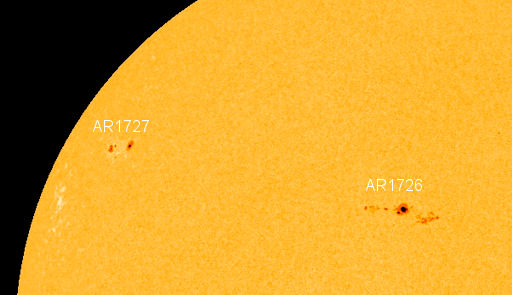LYRID METEOR SHOWER: Earth is entering a stream of debris from ancient Comet Thatcher, source of the annual Lyrid Meteor Shower. Usually the shower is mild (10-20 meteors per hour) but unmapped filaments of dust in the comet's tail sometimes trigger outbursts ten times stronger. Forecasters expect the peak to occur on April 21-22. [photo gallery]
TWO NEW SUNSPOTS: On Friday they didn't exist. On Saturday they are big sunspots. Today, sunspots AR1726 and AR1727 are rapidly emerging in the sun's northern hemisphere. The larger of the two, AR1726, contains nearly a dozen dark cores and spans 125,000 km from end to end. Click to view a 24-hour movie recorded by NASA's Solar Dynamics Observatory:
AR1726 is the fastest-growing and, so far, the most active. It is crackling with C-class flares and seems capable of producing even stronger M-class eruptions. Because of the sunspot's central location on the solar disk, any explosions this weekend will be Earth-directed. Stay tuned. Solar flare alerts: text, voice.
CME TARGETS MERCURY: The magnetic canopy of sunspot AR1719 erupted during the late hours of April 18th, hurling a bright CME into space. The Solar and Heliospheric Observatory photographed the cloud racing away from the sun's western limb:
Earth was not in the line of fire. Instead, the CME is heading for Mercury: ETA April 20th. NASA's MESSENGER probe in orbit around Mercury will be monitoring the effects of the impact. If the CME overwhelms Mercury's relatively weak magnetic field, it could scour material off the planet's surface creating a temporary atmosphere and adding material to Mercury's comet-like tail.
Realtime Space Weather Photo Gallery
Realtime Noctilucent Cloud Photo Gallery
[previous years: 2003, 2004, 2005, 2006, 2007, 2008, 2009, 2011]

![]()
Solar wind
speed: 306.2 km/sec
density: 2.6 protons/cm3
explanation | more data
Updated: Today at 1437 UT
![]()
X-ray Solar Flares
6-hr max: C1 0802 UT Apr20
24-hr: C1 0036 UT Apr20
explanation | more data
Updated: Today at: 1400 UT
![]()
![]()
![]()
Daily Sun: 20 Apr 13
![]()
![]()
Two new sunspots are rapidly growing in the sun's northern hemisphere: AR1726 and AR1727.Credit: SDO/HMI
![]()
![]()
![]()
Sunspot number: 101
What is the sunspot number?
Updated 20 Apr 2013
Spotless Days
Current Stretch: 0 days
2013 total: 0 days (0%)
2012 total: 0 days (0%)
2011 total: 2 days (<1%)
2010 total: 51 days (14%)
2009 total: 260 days (71%)
Since 2004: 821 days
Typical Solar Min: 486 days
Update 20 Apr 2013
The Radio Sun
10.7 cm flux: 99 sfu
explanation | more data
Updated 19 Apr 2013
![]()
![]()
![]()
Current Auroral Oval:
![]()
Switch to: Europe, USA, New Zealand, Antarctica
Credit: NOAA/POES
![]()
![]()
![]()
Planetary K-index
Now: Kp= 2 quiet
24-hr max: Kp= 2 quiet
explanation | more data
![]()
Interplanetary Mag. Field
Btotal: 5.5 nT
Bz: 2.7 nT north
explanation | more data
Updated: Today at 1437 UT
![]()
![]()
![]()
Coronal Holes: 20 Apr 13
![]()
![]()
Solar wind flowing from this major coronal hole could reach Earth on April 25-27. Credit: SDO/AIA.






